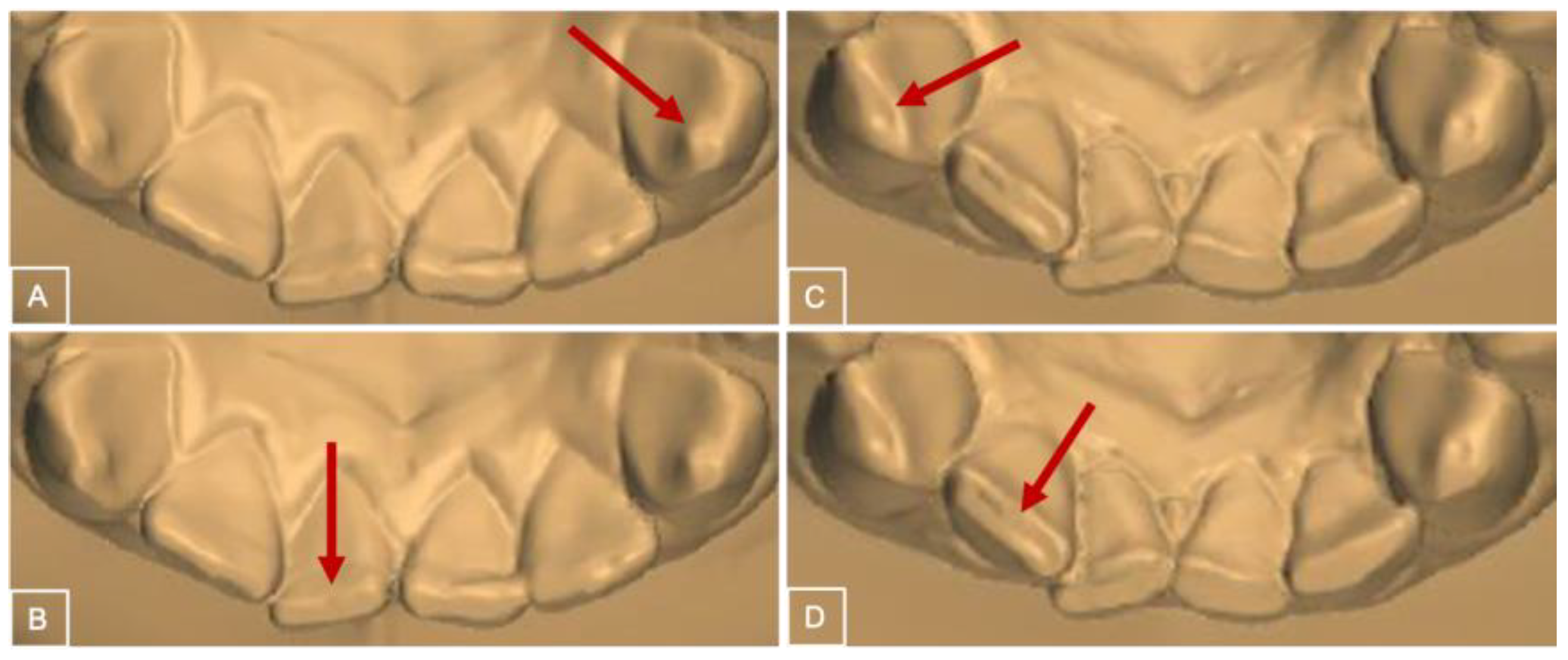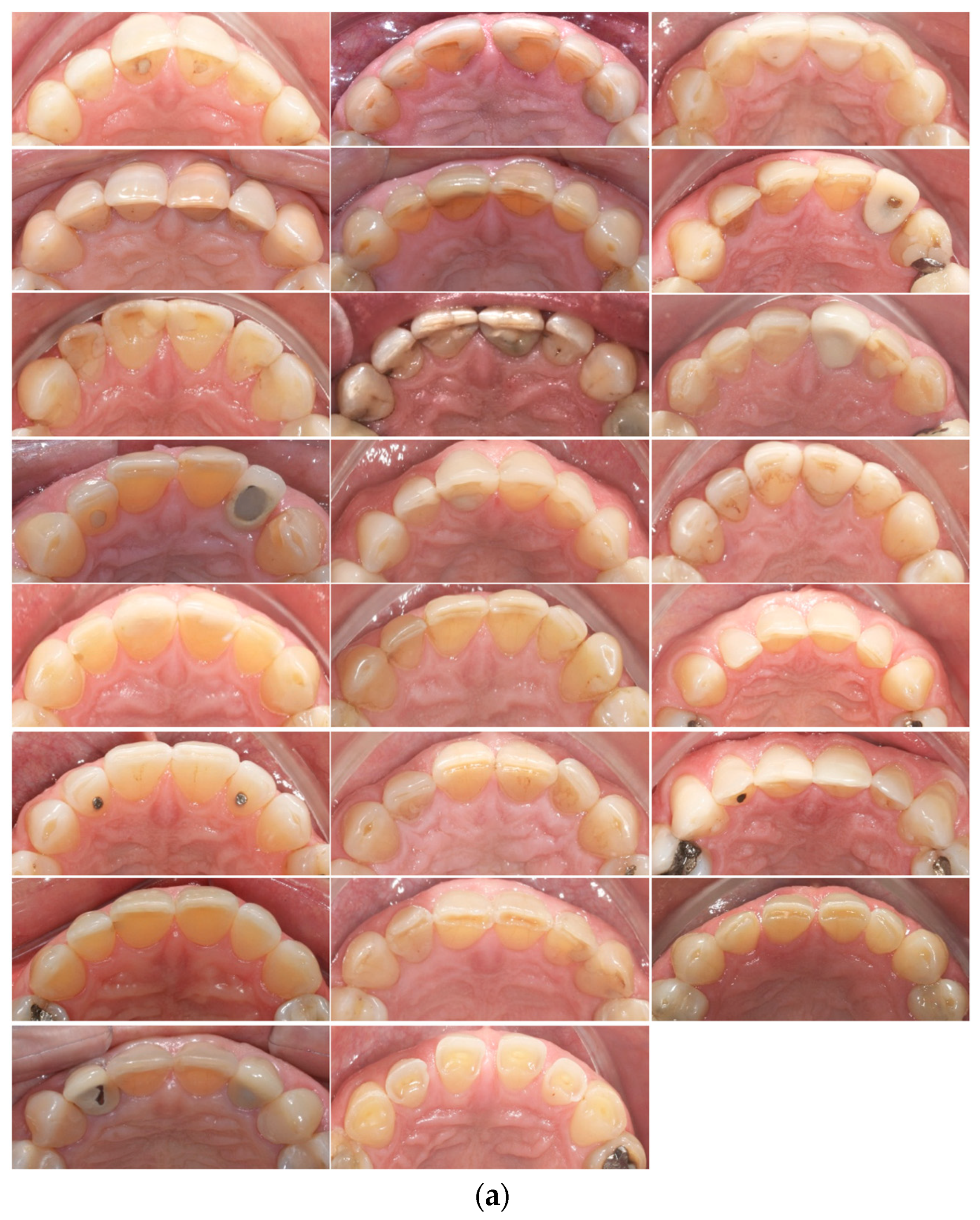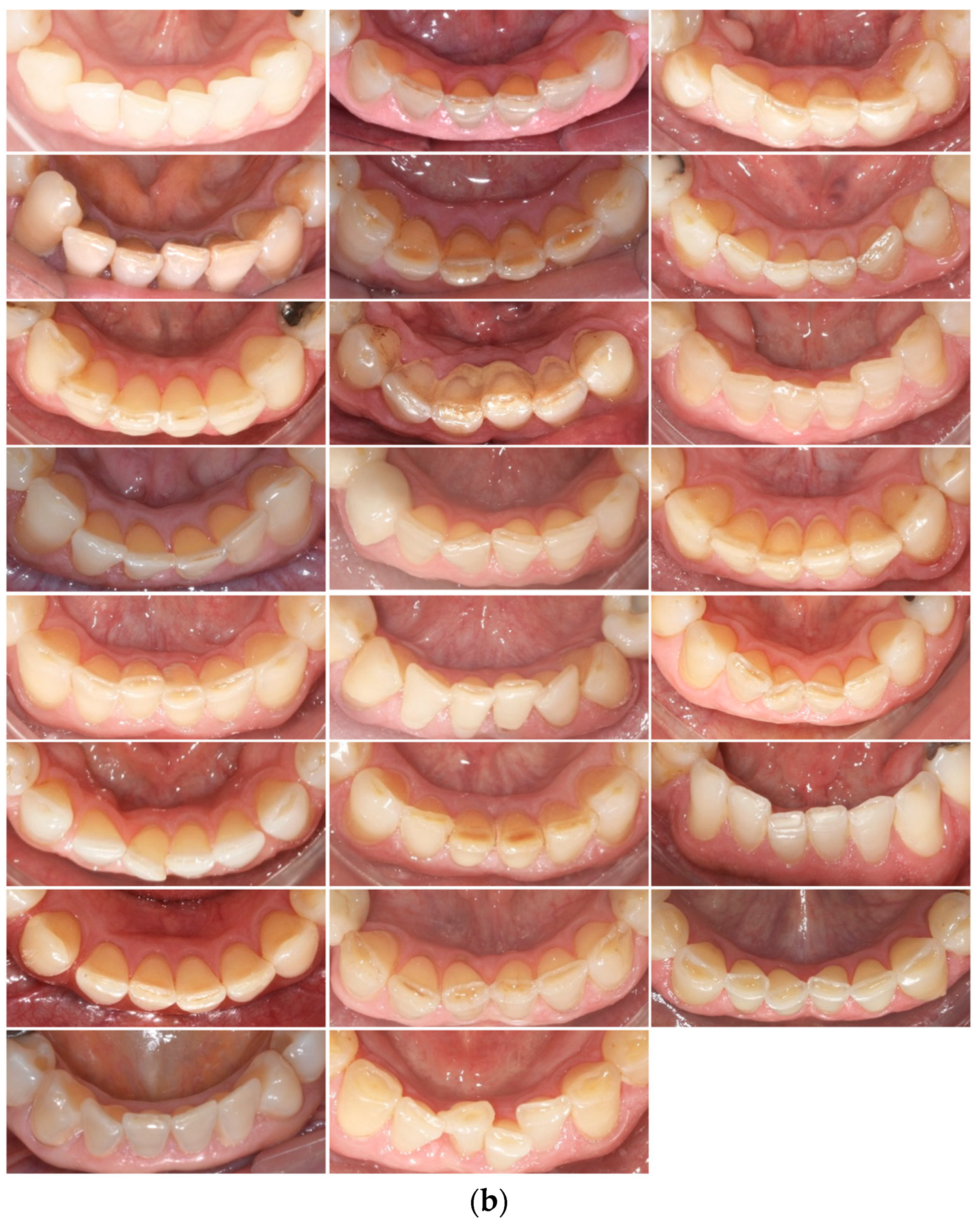Erosive Tooth Wear in Subjects with Normal Occlusion: A Pioneering Longitudinal Study up to the Age of 60
Abstract
1. Introduction
2. Materials and Methods
Statistical Analyses
3. Results
4. Discussion
5. Conclusions
Author Contributions
Funding
Institutional Review Board Statement
Informed Consent Statement
Data Availability Statement
Conflicts of Interest
References
- Schlueter, N.; Amaechi, B.T.; Bartlett, D.; Buzalaf, M.A.R.; Carvalho, T.S.; Ganss, C.; Hara, A.T.; Huysmans, M.-C.D.; Lussi, A.; Moazzez, R. Terminology of erosive tooth Wear: Consensus report of a workshop organized by the ORCA and the Cariology research group of the IADR. Caries Res. 2020, 54, 2–6. [Google Scholar] [CrossRef] [PubMed]
- Moazzez, R.; Anggiansah, A.; Bartlett, D.W. The Association of Acidic Reflux above the Upper Oesophageal Sphincter with Palatal Tooth Wear. Caries Res. 2005, 39, 475–478. [Google Scholar] [CrossRef] [PubMed]
- Thordarson, A.; Zachrisson, B.U.; Mjor, I.A. Remodeling of canines to the shape of lateral incisors by grinding: A long-term clinical and radiographic evaluation. Am. J. Orthod. Dentofac. Orthop. Off. Publ. Am. Assoc. Orthod. Its Const. Soc. Am. Board Orthod. 1991, 100, 123–132. [Google Scholar] [CrossRef] [PubMed]
- Lussi, A.; Carvalho, T.S. Erosive tooth wear: A multifactorial condition of growing concern and increasing knowledge. Erosive Tooth Wear 2014, 25, 1–15. [Google Scholar]
- d’Incau, E.; Couture, C.; Maureille, B. Human tooth wear in the past and the present: Tribological mechanisms, scoring systems, dental and skeletal compensations. Arch. Oral Biol. 2012, 57, 214–229. [Google Scholar] [CrossRef] [PubMed]
- Holbrook, W.P.; Arnadottir, I.B.; Hloethversson, S.O.; Arnarsdottir, E.; Jonsson, S.H.; Saemundsson, S.R. The Basic Erosive Wear Examination (BEWE) applied retrospectively to two studies. Clin. Oral Investig. 2014, 18, 1625–1629. [Google Scholar] [CrossRef]
- Bartlett, D. A personal perspective and update on erosive tooth wear—10 years on: Part 1—Diagnosis and prevention. Br. Dent. J. 2016, 221, 115–119. [Google Scholar] [CrossRef]
- Bartlett, D.; Ganss, C.; Lussi, A. Basic Erosive Wear Examination (BEWE): A new scoring system for scientific and clinical needs. Clin. Oral Investig. 2008, 12 (Suppl. S1), S65–S68. [Google Scholar] [CrossRef]
- Ganss, C.; Young, A.; Lussi, A. Tooth wear and erosion: Methodological issues in epidemiological and public health research and the future research agenda. Community Dent. Health 2011, 28, 191–195. [Google Scholar]
- Van’t Spijker, A.; Rodriguez, J.M.; Kreulen, C.M.; Bronkhorst, E.M.; Bartlett, D.W.; Creugers, N.H. Prevalence of tooth wear in adults. Int. J. Prosthodont. 2009, 22, 35–42. [Google Scholar]
- Vered, Y.; Lussi, A.; Zini, A.; Gleitman, J.; Sgan-Cohen, H.D. Dental erosive wear assessment among adolescents and adults utilizing the basic erosive wear examination (BEWE) scoring system. Clin. Oral Investig. 2014, 18, 1985–1990. [Google Scholar] [CrossRef] [PubMed]
- Bartlett, D.W.; Lussi, A.; West, N.X.; Bouchard, P.; Sanz, M.; Bourgeois, D. Prevalence of tooth wear on buccal and lingual surfaces and possible risk factors in young European adults. J. Dent. 2013, 41, 1007–1013. [Google Scholar] [CrossRef]
- Marro, F.; De Lat, L.; Martens, L.; Jacquet, W.; Bottenberg, P. Monitoring the progression of erosive tooth wear (ETW) using BEWE index in casts and their 3D images: A retrospective longitudinal study. J. Dent. 2018, 73, 70–75. [Google Scholar] [CrossRef] [PubMed]
- Ganss, C.; Klimek, J.; Giese, K. Dental erosion in children and adolescents—A cross-sectional and longitudinal investigation using study models. Community Dent. Oral Epidemiol. 2001, 29, 264–271. [Google Scholar] [CrossRef] [PubMed]
- Knight, D.J.; Leroux, B.G.; Zhu, C.; Almond, J.; Ramsay, D.S. A longitudinal study of tooth wear in orthodontically treated patients. Am. J. Orthod. Dentofac. Orthop. 1997, 112, 194–202. [Google Scholar] [CrossRef] [PubMed]
- Massaro, C.; Miranda, F.; Janson, G.; de Almeida, R.R.; Pinzan, A.; Martins, D.R.; Garib, D. Maturational changes of the normal occlusion: A 40-year follow-up. Am. J. Orthod. Dentofac. Orthop. Off. Publ. Am. Assoc. Orthod. Its Const. Soc. Am. Board Orthod. 2018, 154, 188–200. [Google Scholar] [CrossRef] [PubMed]
- Mulic, A.; Tveit, A.B.; Wang, N.J.; Hove, L.H.; Espelid, I.; Skaare, A.B. Reliability of two clinical scoring systems for dental erosive wear. Caries Res. 2010, 44, 294–299. [Google Scholar] [CrossRef][Green Version]
- Margaritis, V.; Mamai-Homata, E.; Koletsi-Kounari, H.; Polychronopoulou, A. Evaluation of three different scoring systems for dental erosion: A comparative study in adolescents. J. Dent. 2011, 39, 88–93. [Google Scholar] [CrossRef]
- Olley, R.C.; Wilson, R.; Bartlett, D.; Moazzez, R. Validation of the Basic Erosive Wear Examination. Caries Res. 2014, 48, 51–56. [Google Scholar] [CrossRef]
- Bartlett, D.; Dattani, S.; Mills, I.; Pitts, N.; Rattan, R.; Rochford, D.; Wilson, N.H.F.; Mehta, S.; O’Toole, S. Monitoring erosive toothwear: BEWE, a simple tool to protect patients and the profession. Br. Dent. J. 2019, 226, 930–932. [Google Scholar] [CrossRef]
- Alaraudanjoki, V.; Saarela, H.; Pesonen, R.; Laitala, M.L.; Kiviahde, H.; Tjaderhane, L.; Lussi, A.; Pesonen, P.; Anttonen, V. Is a Basic Erosive Wear Examination (BEWE) reliable for recording erosive tooth wear on 3D models? J. Dent. 2017, 59, 26–32. [Google Scholar] [CrossRef]
- Wohlrab, T.; Flechtenmacher, S.; Krisam, J.; Saure, D.; Wolff, D.; Frese, C. Diagnostic Value of the Basic Erosive Wear Examination for the Assessment of Dental Erosion on Patients, Dental Photographs, and Dental Casts. Oper. Dent. 2019, 44, E279–E288. [Google Scholar] [CrossRef] [PubMed]
- Carvalho, T.; Lussi, A. Age-related morphological, histological and functional changes in teeth. J. Oral Rehabil. 2017, 44, 291–298. [Google Scholar] [CrossRef] [PubMed]
- Bartlett, D.; O’Toole, S. Tooth wear and aging. Aust. Dent. J. 2019, 64 (Suppl. S1), S59–S62. [Google Scholar] [CrossRef] [PubMed]
- Dejak, B.; Bołtacz-Rzepkowska, E. Mechanism of enamel damage in the grooves of molars during mastication. Dent. Med. Probl. 2023, 60, 321–326. [Google Scholar] [CrossRef]
- Dugmore, C.R.; Rock, W.P. The prevalence of tooth erosion in 12-year-old children. Br. Dent. J. 2004, 196, 279–282; discussion 273. [Google Scholar] [CrossRef] [PubMed]
- El Aidi, H.; Bronkhorst, E.M.; Truin, G.J. A longitudinal study of tooth erosion in adolescents. J. Dent. Res. 2008, 87, 731–735. [Google Scholar] [CrossRef]
- McGuire, J.; Szabo, A.; Jackson, S.; Bradley, T.G.; Okunseri, C. Erosive tooth wear among children in the United States: Relationship to race/ethnicity and obesity. Int. J. Paediatr. Dent. 2009, 19, 91–98. [Google Scholar] [CrossRef]
- Gambon, D.L.; Brand, H.S.; Veerman, E.C. Dental erosion in the 21st century: What is happening to nutritional habits and lifestyle in our society? Br. Dent. J. 2012, 213, 55–57. [Google Scholar] [CrossRef]
- Mulic, A.; Tveit, A.B.; Songe, D.; Sivertsen, H.; Skaare, A.B. Dental erosive wear and salivary flow rate in physically active young adults. BMC Oral Health 2012, 12, 8. [Google Scholar] [CrossRef]
- Gurgel, C.V.; Rios, D.; Buzalaf, M.A.; da Silva, S.M.; Araujo, J.J.; Pauletto, A.R.; de Andrade Moreira Machado, M.A. Dental erosion in a group of 12- and 16-year-old Brazilian schoolchildren. Pediatr. Dent. 2011, 33, 23–28. [Google Scholar]
- Wang, P.; Lin, H.C.; Chen, J.H.; Liang, H.Y. The prevalence of dental erosion and associated risk factors in 12-13-year-old school children in Southern China. BMC Public Health 2010, 10, 478. [Google Scholar] [CrossRef]
- Sun, K.; Wang, W.; Wang, X.; Shi, X.; Si, Y.; Zheng, S. Tooth wear: A cross-sectional investigation of the prevalence and risk factors in Beijing, China. BDJ Open 2017, 3, 16012. [Google Scholar] [CrossRef] [PubMed]
- Schierz, O.; Dommel, S.; Hirsch, C.; Reissmann, D.R. Occlusal tooth wear in the general population of Germany: Effects of age, sex, and location of teeth. J. Prosthet. Dent. 2014, 112, 465–471. [Google Scholar] [CrossRef] [PubMed]
- Ab Halim, N.; Esa, R.; Chew, H.P. General and erosive tooth wear of 16-year-old adolescents in Kuantan, Malaysia: Prevalence and association with dental caries. BMC Oral Health 2018, 18, 11. [Google Scholar] [CrossRef] [PubMed]
- Liu, B.; Zhang, M.; Chen, Y.; Yao, Y. Tooth wear in aging people: An investigation of the prevalence and the influential factors of incisal/occlusal tooth wear in northwest China. BMC Oral Health 2014, 14, 65. [Google Scholar] [CrossRef]
- Auad, S.M.; Waterhouse, P.J.; Nunn, J.H.; Steen, N.; Moynihan, P.J. Dental erosion amongst 13-and 14-year-old Brazilian schoolchildren. Int. Dent. J. 2007, 57, 161–167. [Google Scholar] [CrossRef]
- Mangueira, D.F.; Sampaio, F.C.; Oliveira, A.F. Association between socioeconomic factors and dental erosion in Brazilian schoolchildren. J. Public Health Dent. 2009, 69, 254–259. [Google Scholar] [CrossRef]
- Lussi, A.; Schaffner, M.; Hotz, P.; Suter, P. Dental erosion in a population of Swiss adults. Community Dent. Oral Epidemiol. 1991, 19, 286–290. [Google Scholar] [CrossRef]
- Nystrom, M.; Kononen, M.; Alaluusua, S.; Evalahti, M.; Vartiovaara, J. Development of horizontal tooth wear in maxillary anterior teeth from five to 18 years of age. J. Dent. Res. 1990, 69, 1765–1770. [Google Scholar] [CrossRef]
- Bishara, S.E.; Treder, J.E.; Damon, P.; Olsen, M. Changes in the dental arches and dentition between 25 and 45 years of age. Angle Orthod. 1996, 66, 417–422. [Google Scholar] [PubMed]
- Harris, E.F. A longitudinal study of arch size and form in untreated adults. Am. J. Orthod. Dentofac. Orthop. 1997, 111, 419–427. [Google Scholar] [CrossRef] [PubMed]
- Skośkiewicz-Malinowska, K.; Noack, B.; Kaderali, L.; Malicka, B.; Lorenz, K.; Walczak, K.; Weber, M.-T.; Mendak-Ziółko, M.; Hoffmann, T.; Ziętek, M. Oral health and quality of life in old age: A cross-sectional pilot project in Germany and Poland. Adv. Clin. Exp. Med. 2016, 25, 951–959. [Google Scholar] [CrossRef] [PubMed]



| Teeth | Lost and Not Replaced | Dental Implant | Prosthesis | Evaluated | Total | |
|---|---|---|---|---|---|---|
| Maxillary | 16/26 | 10 | 1 | 7 | 22 | 46 |
| 15/25 | 3 | 1 | 8 | 34 | ||
| 14/24 | 1 | 0 | 8 | 37 | ||
| 13/23 | 0 | 0 | 1 | 45 | ||
| 12/22 | 0 | 1 | 3 | 42 | ||
| 11/21 | 0 | 0 | 3 | 43 | ||
| Mandibular | 36/46 | 6 | 11 | 11 | 18 | 46 |
| 35/45 | 1 | 5 | 7 | 33 | ||
| 34/44 | 2 | 2 | 3 | 39 | ||
| 33/43 | 0 | 0 | 2 | 44 | ||
| 32/42 | 0 | 0 | 0 | 46 | ||
| 31/41 | 0 | 0 | 0 | 46 |
| T0–13 Years | T1–17 Years | T2–61 Years | p Value | |||||||
|---|---|---|---|---|---|---|---|---|---|---|
| BEWE score | Median | 25% | 75% | Median | 25% | 75% | Median | 25% | 75% | <0.001 * |
| 2.00 A | 1.00 | 2.00 | 4.00 B | 3.00 | 5.00 | 7.00 C | 5.00 | 10.00 | ||
| Predictor | Estimate | SE | Z | p Value | Odds Ratio | 95% CI | ||
|---|---|---|---|---|---|---|---|---|
| Lower | Upper | |||||||
| Sex (male versus female) | 0.43 | 0.14 | 3.02 | 0.003 * | 1.54 | 1.16 | 2.03 | |
| Dental arch (maxillary versus mandibular) | 0.24 | 0.14 | 1.72 | 0.086 | 1.27 | 0.97 | 1.66 | |
| Tooth Region | Incisor-premolar | 1.51 | 0.19 | 8.13 | <0.001 * | 4.72 | 3.26 | 6.90 |
| Canine-premolar | 0.82 | 0.21 | 3.80 | <0.001 * | 2.26 | 1.49 | 3.45 | |
| Molar-premolar | 0.58 | 0.34 | 1.71 | 0.087 | 1.78 | 0.90 | 3.39 | |
| Surface | Incisal/occlusal-buccal | 4.98 | 0.24 | 20.94 | <0.001 * | 144.83 | 91.91 | 233.45 |
| Lingual-buccal | 0.78 | 0.18 | 4.33 | <0.001 * | 2.19 | 1.54 | 3.13 | |
| Subgroups | N | T1-ETW Mean | SD | p Value | 95% CI | |
|---|---|---|---|---|---|---|
| Lower | Upper | |||||
| BEWE score below T2 median | 13 | 3.308 | 1.182 | 0.018 * | 2.59 | 4.02 |
| BEWE score above T2 median | 10 | 4.700 | 1.418 | 3.69 | 5.71 | |
Disclaimer/Publisher’s Note: The statements, opinions and data contained in all publications are solely those of the individual author(s) and contributor(s) and not of MDPI and/or the editor(s). MDPI and/or the editor(s) disclaim responsibility for any injury to people or property resulting from any ideas, methods, instructions or products referred to in the content. |
© 2023 by the authors. Licensee MDPI, Basel, Switzerland. This article is an open access article distributed under the terms and conditions of the Creative Commons Attribution (CC BY) license (https://creativecommons.org/licenses/by/4.0/).
Share and Cite
Eto, H.C.; Miranda, F.; Rios, D.; Honório, H.M.; Janson, G.; Massaro, C.; Garib, D. Erosive Tooth Wear in Subjects with Normal Occlusion: A Pioneering Longitudinal Study up to the Age of 60. J. Clin. Med. 2023, 12, 6318. https://doi.org/10.3390/jcm12196318
Eto HC, Miranda F, Rios D, Honório HM, Janson G, Massaro C, Garib D. Erosive Tooth Wear in Subjects with Normal Occlusion: A Pioneering Longitudinal Study up to the Age of 60. Journal of Clinical Medicine. 2023; 12(19):6318. https://doi.org/10.3390/jcm12196318
Chicago/Turabian StyleEto, Henrique Campos, Felicia Miranda, Daniela Rios, Heitor Marques Honório, Guilherme Janson, Camila Massaro, and Daniela Garib. 2023. "Erosive Tooth Wear in Subjects with Normal Occlusion: A Pioneering Longitudinal Study up to the Age of 60" Journal of Clinical Medicine 12, no. 19: 6318. https://doi.org/10.3390/jcm12196318
APA StyleEto, H. C., Miranda, F., Rios, D., Honório, H. M., Janson, G., Massaro, C., & Garib, D. (2023). Erosive Tooth Wear in Subjects with Normal Occlusion: A Pioneering Longitudinal Study up to the Age of 60. Journal of Clinical Medicine, 12(19), 6318. https://doi.org/10.3390/jcm12196318










